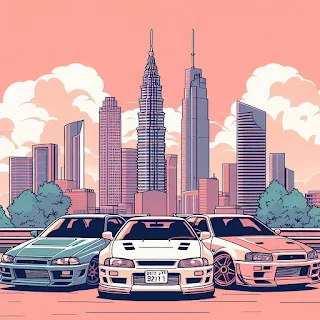Graphics have come a long way in the rapidly changing world of digital media, taking us from simple early days to fully realized virtual environments that straddle the line between fact and fantasy. The fascinating history of graphics progression spans decades of invention and amazement and tells the story of human inventiveness, technical advances, and an unbroken quest of visual perfection.
Chapter 1: The Origin of Pixels
Graphics were only abstractions in the early days of computer, limited to simple forms and monochromatic screens. However, these rudimentary pixels contained the seeds of a revolution. Our ideas were sparked by pioneers like Atari and Nintendo, exposing us to the joys of interactive gaming with titles like "Space Invaders" and "Pong." From the flashing pixels of these arcade classics to the recognizable 8-bit sprites of "Super Mario Bros.," these pioneering visuals set the stage for a rapidly emerging global business that would inspire many artists, developers, and innovators.Chapter 2: 3D's Ascent
With the development of technology, the possibilities for graphics grew, and the world of three dimensions became a new frontier. An important turning point that ushered in a new era of depth and realism was the switch from 2D to 3D. Games like as "Quake" and "Doom" reshaped our expectations by putting us in real, living situations. Virtual worlds were constructed using textures and polygons, and the quest of photorealism turned into an obsession that spurred constant innovation.Hardware and software developments opened the door for ever-more intricate graphics pipelines, allowing real-time rendering methods that allowed our screens to display previously unheard-of levels of fidelity and complexity. Static settings were changed into dynamic, living worlds that responded to our choices and activities via the use of lighting, shading, and special effects.
Chapter 3: The Era of Realism
With each technological leap, graphics evolved, pushing the limits of what was possible. Real-time rendering techniques, such as ray tracing and global illumination, brought unprecedented realism to our screens. Character models became indistinguishable from their real-world counterparts, with intricate details and lifelike animations that captured the subtleties of human expression and movement. Environments took on a lifelike quality that blurred the line between virtual and physical, with convincing physics simulations, dynamic weather systems, and intricate particle effects.
But graphics were not confined to the realm of gaming alone. Visual effects in films and television shows reached new heights, transporting audiences to fantastical realms and immersing them in spectacles that defied the laws of physics. From the epic battles of "The Lord of the Rings" trilogy to the mind-bending worlds of "Inception," graphics played a pivotal role in bringing these cinematic visions to life, seamlessly blending reality and imagination.
Chapter 4: The Advent of Virtual Reality
As we stand on the precipice of the next great technological leap, virtual reality (VR) and augmented reality (AR) are poised to redefine our relationship with graphics. These cutting-edge technologies offer a level of immersion that transcends traditional displays, allowing us to step into fully realized virtual worlds and interact with them in ways that were once unimaginable.
With the advent of powerful headsets and motion tracking technologies, we can now explore digital environments as if we were physically present within them. The boundaries between the virtual and the real dissolve, as our senses are enveloped in a tapestry of sights, sounds, and sensations that transport us to realms limited only by our imagination.
The potential applications of VR and AR span far beyond entertainment, with profound implications for fields such as education, medicine, and industrial design. Imagine exploring the intricacies of the human body in a virtual anatomy lab, or walking through the streets of ancient civilizations as if you were there in person. Architects can visualize and iterate on designs in real-time, while engineers can simulate complex systems and scenarios before ever breaking ground.
Chapter 5: The Future Beckons
As we gaze into the future, the possibilities for graphics evolution are limitless. Advancements in artificial intelligence, quantum computing, and nanotechnology promise to revolutionize the way we create, render, and experience graphics. Perhaps we will one day inhabit fully realized virtual universes, indistinguishable from our own reality, or even merge the digital and physical realms into a seamless, augmented existence.
The convergence of graphics, artificial intelligence, and advanced computing power could give rise to truly intelligent virtual worlds, where characters and environments adapt and evolve in response to our actions and decisions. Imagine stepping into a living, breathing fantasy realm where the line between player and character blurs, and the narrative unfolds dynamically, driven by our choices and the emergent behaviours of the virtual denizens.
Furthermore, the advent of quantum computing and its ability to perform calculations at unprecedented speeds could unlock new frontiers in real-time rendering, enabling us to generate and manipulate complex environments and simulations with unparalleled fidelity and detail.
The journey of graphics evolution is a testament to human creativity and our relentless pursuit of technological progress. From the humble pixels of yesteryear to the virtual realms of tomorrow, graphics have captivated our imaginations and pushed the boundaries of what is possible. As we embark on the next chapter of this incredible odyssey, one thing is certain: the best is yet to come, and the realms of visual wizardry we have yet to explore are limited only by the bounds of our imagination and our determination to push the boundaries of what is possible.












0 Comments